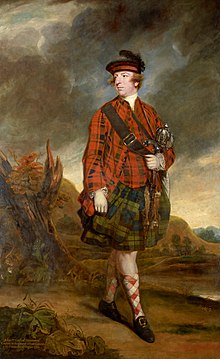
Back حرب اللورد دونمور Arabic Guerra de Lord Dunmore Spanish Lordi Dunmoren sota Finnish Guerre de Dunmore French Guerra di Lord Dunmore Italian ダンモアの戦争 Japanese Lord Dunmores krig NB Wojna lorda Dunmore’a Polish Война Данмора Russian Данморов рат Serbian
| Lord Dunmore's War | |||||||
|---|---|---|---|---|---|---|---|
| Part of the American Indian Wars | |||||||
 John Murray, 4th Earl of Dunmore, for whom the war is named. | |||||||
| |||||||
| Belligerents | |||||||
|
Shawnees Mingos |
| ||||||
| Commanders and leaders | |||||||
|
Hokolesqua Talgayeeta |
Lord Dunmore Andrew Lewis Angus McDonald William Crawford | ||||||
This article includes a list of references, related reading, or external links, but its sources remain unclear because it lacks inline citations. (April 2023) |
Lord Dunmore's War, also known as Dunmore's War, was a brief conflict in fall 1774 between the British Colony of Virginia and the Shawnee and Mingo in the trans-Appalachian region of the colony south of the Ohio River. Broadly, the war included events between May and October 1774. The governor of Virginia during the conflict was John Murray, 4th Earl of Dunmore, who in May 1774, asked the House of Burgesses to declare a state of war with the Indians and call out the Virginia militia.
The conflict resulted from escalating violence between white settlers, who, in accordance with previous treaties, especially the Treaty of Fort Stanwix (1768), were exploring and moving into land south of the Ohio River (modern West Virginia, southwestern Pennsylvania, and Kentucky), and the Ohio Country Shawnee who had historical hunting rights in the south of Ohio lands of the Iroquois Confederacy. Resulting cross-river attacks by the Shawnee caused war to be declared "to pacify the hostile Indian war bands"[citation needed]. The war ended soon after Virginia's victory in the Battle of Point Pleasant on October 10, 1774. In the ensuing Treaty of Camp Charlotte, the Native Americans surrendered their hunting rights south of the Ohio, and agreed to cease attacks upon travelers on the river and recognize the river, running nearly north–south at its eastern end, as the boundary between Indian lands of Ohio Country to the west, and the Colonies to the east. This was a major resetting of the Appalachian boundary defined by the Royal Proclamation of 1763 which ended the French and Indian War.
Although the Indian national chieftains signed the treaty, conflict within the Indian nations soon broke out. Some tribesmen felt the treaty sold out their claims and opposed it, and others believed that another war would mean only further losses of territory to the settlers. When the American Revolutionary War broke out between the American settlers and the British in 1776, the war parties of the Indian nations quickly gained power. They mobilized the various Indian nations to ally with the British during the war, initiating the Cherokee-American wars that lasted nearly two decades.
© MMXXIII Rich X Search. We shall prevail. All rights reserved. Rich X Search